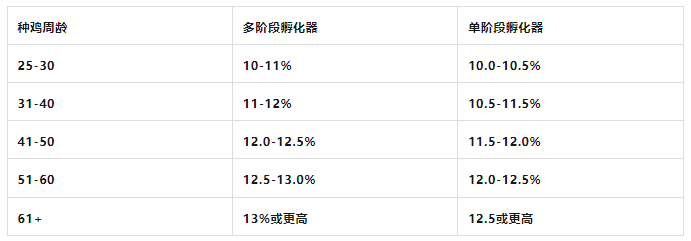There are many factors related to moisture loss, including humidity Settings, throttle positioning, changes in ventilation pressure differences, and atmospheric conditions. The percentage of water loss can vary depending on the week age of the breeder flock, seasonal effects, or the size of the eggs. By visually measuring the size of the air chamber and the condition of the chicks, it is possible to assess the degree of water loss sufficient to achieve hatchability and chick quality.
During hatching, water vapor is lost from the egg through the pores in the shell. The rate of water loss depends on the number and size of pores around the egg (the gas conductance of the eggshell) and the humidity in the air. Due to differences in eggshell structure and gas conductance, water loss changes when all eggs hatch under the same humidity conditions. For eggs from broiler breeders, this variation usually does not have a significant effect on hatchability. However, when age, nutrition, or disease reduce the quality of the eggs, it may be necessary to adjust the humidity conditions of the incubator to maintain hatching rates and chick quality.
Water loss rate after 18.5 days of incubation

Animal welfare Tips
Egg water loss has important effects on hatching rate, hatching window and quality of chicks. Improper egg moisture loss can lead to chick welfare issues (e.g. red joints, size, and bone structure), which can have long-term negative effects on chicks.
Egg water loss mark
Single-stage incubators can set incubation conditions according to embryo age. In order to achieve water loss, there are 4 different factors that affect the amount and rate of water loss:
Relative humidity - A relative humidity percentage set according to the specific date of incubation will help with water loss.
Damper - Moisture removal is also affected by the extent to which the incubator damper can be opened on the day.
Heat - Temperature also affects the amount of water lost. High eggshell temperatures increase the amount of water lost.
Ventilation ratio - The air exchange ratio requirements are determined by the machine model/type, and the air exchange ratio will determine the loss of moisture.
In a multi-stage incubator, it is possible to make slight adjustments to the air conditions to help achieve a reasonable level of water loss. There are two factors that affect the water loss rate of multi-stage incubator:
Relative humidity - The relative humidity level in the incubator.
Air conditioning - The air conditions that enter the machine.
A spotlight or flashlight can be used to determine the size of the egg's gas chamber before it is placed on the tray. An air chamber that is too large can be a sign of excessive water loss.
Chicks that hatch prematurely due to excessive water loss may experience high incubation temperatures. Insufficient water loss can also cause the brood window to move earlier than expected, resulting in dehydrating chicks at brood. The level of water loss needs to be assessed to ensure the exact cause of the chick window movement. This is why the calculation of water loss can help with diagnosis.
When performing egg-beating analysis, it is important to closely observe post-embryonic mortality. When the chick has passed through the inner shell membrane without pecking outside the shell, this may be a sign of too much water loss. Be sure to investigate these findings in order to better assess the exact cause of embryo death.
The air chamber of the egg should be at least one-third the size of the egg, or just above the middle of the egg when it is placed on the pan. Where the chick pecks out of the shell can be an indicator of water loss. During the breaking process, the chick's head should be level. If the head becomes inverted or tilted upward in appearance, this is a sign that the eggs are not losing enough water.
Signs of low percentage of egg water loss:
Air chamber too small
Baby chicken fuzz clings to pieces of eggshell
Bigger than a normal chick
Red tarsus, bruising of beak or nostrils
Abdominal enlargement
The chicken has shards of eggshell stuck to it
Signs that the proportion of eggs losing water is too high:
Chicks peck their shells early
The chicks hatch early
Dehydration of chicks
The chicks are smaller than normal
The air chamber is too large
Embryo death at 20 days (internal pecking)






